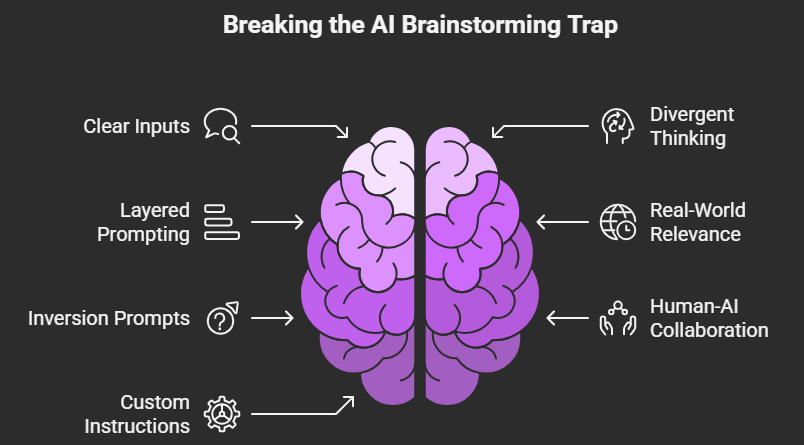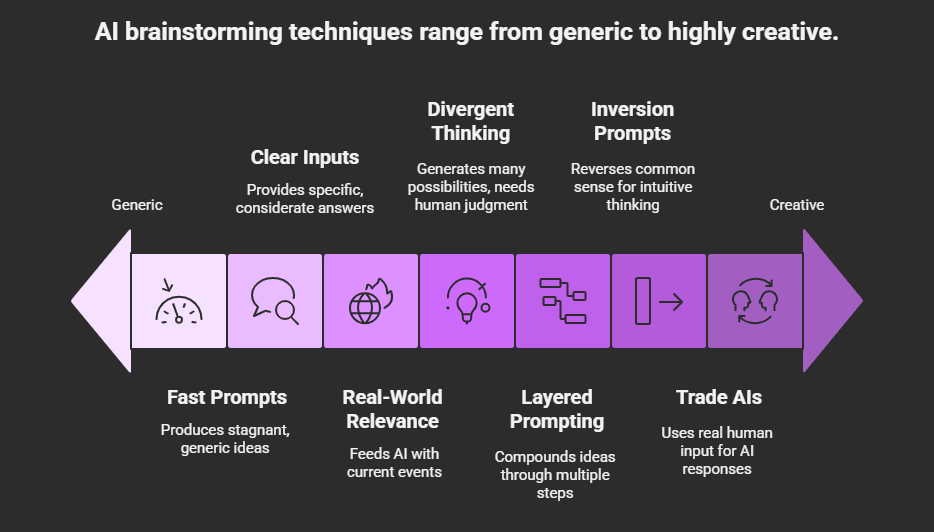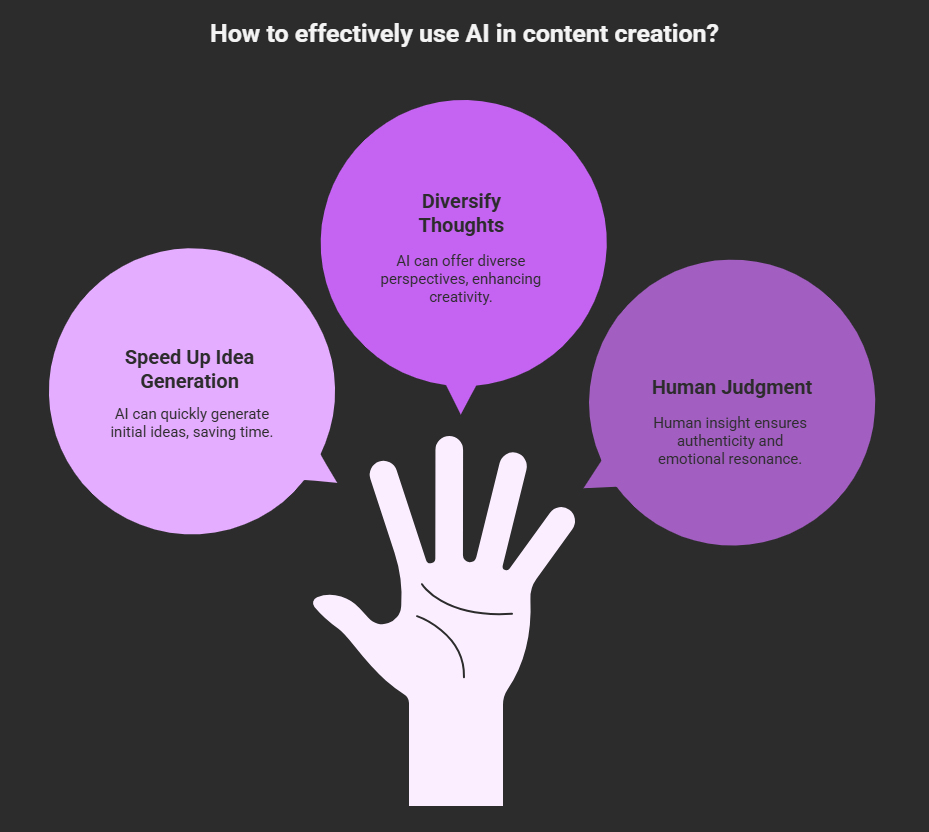How to Use AI for Content Brainstorming Without Getting Stuck in a Loop

The techniques to employ AI to brainstorm content without going in a loop Have you ever sat and thought at the flashing cursor of an AI chatbot why your tenth request is feeding you the same dry ideas as the first nine? You are not the first one. Whereas AI has the potential to relieve us of our creative dilemma, it has led many of us into the echo chamber of mediocrity instead.
Brainstorming Trap

AI tools are, without a doubt, very potent in helping people generate ideas; they are quick, large-scale, and never call in sick. They will ease the curse of the blank page since... well, since there were blank pages.
The issue many content makers are encountering, however, is that there are only so many ideas they can use, there are only so many familiar tones they can employ, and if nothing structurally exciting comes out, it is anything but exciting. You request the ideas on your blog posts and get half a dozen versions of the same 10 tips for better marketing that could have been written over the past ten years.
The fact that I get suggestions to read the same generic-sounding content repeatedly may make one wonder what AI is trying to achieve or create a situation where all the content is sampled into one mega-mass of editable web-based dribble.
It is not random to harness AI, and the aim is not to be able to break the loop and get new, human-first ideas powered by AI that are not determined by it.
Having literally wasted tens of hours attempting to force a few original ideas out of some AI-based tool (and occasionally felt like throwing my laptop at the wall to get this mind-numbing process over with), I have ended up learning a few tactics that can be used to produce something new. I will tell you about that.
1. Begin with Clear Inputs, Not Fast Prompts
Only a high-quality input can ensure a high-quality output for the AI. It would sound so basic; however, it is appalling how Word, not Action, many of us still treat AI with sloppy-built prompts.
But do not say: "Tell me blog ideas about marketing."
Say instead: "I need blog concepts of a Gen Z-oriented SaaS brand that launches in Q2 2025 and within the scope of AI ethics-related issues and product benefit demonstration."
Whichever of these ways you take will provide you with the same stagnant list that everyone gets. The other establishes a certain context, so the AI is forced to write more specific and considerate answers.
Context reigns supreme when it comes to dealing with AI. The more exact audience demographics, content purposes, brand voice, and trending are present, the more likely you are to get suggestions that directly apply to your needs rather than generic ones.
It is important to remember that AI is not a mind reader. It is similar to that new kid in the office who requires step-by-step briefing to develop something valuable. You should not hesitate to pen prompts that go a paragraph just in case it will help you get the required specificity.
2. Be an AI Divergent Thinker versus a Final Decision Maker
The biggest mistake most of us make when encountering AI for the first time is the search for THE idea. That is not its strong point.
AI is very good at divergent thinking, which produces many possibilities. It does not do well at convergent thinking, selecting the right alternative after making subtle judgments.
When you want to get an idea for a blog post, do not request the best idea of a blog post; instead, ask for differently-angled approaches to the same subject. Then, use your human judgment to determine which is of true interest or lines up to your unique position in the brand.
Here are some of the immediate methods to foster divergent thinking:
- So, turn these concepts on their heads and make them popular with a new, totally different type of audience.
- Let me hear contrarian opinions on these mainstream subjects
- Consider these ideas as they would be in the world of [surprising industry or persona]
- How would you make this the most out-of-the-box treatment of this subject?
In another case, as you will see from the example, after asking AI to come up with some B2B fintech content ideas, you prompt it to reimagine them for a brand with the personality of Old Spice. The outcomes will be garish but will initiate an authentic new way the audience might adore since it is very surprising in our conservative business.
3. Iterate with Layered Prompting
Prompting one-shot never creates brilliance. Alternatively, view AI-powered brainstorming as a dialogue that compounds itself after numerous steps.
Generalize and then narrow, then patch. This practice's cumulative or layered nature is an analogue to the creative compound interest generated by one prompt on the understanding of the last one.
An instance of layered prompting is given below:
- Prompt 1: "Come up with content themes of digital wellness among working professionals."
- Prompt 2: "With each theme, propose a counterintuitive twist against the crowd's wisdom."
- Prompt 3: Build on the third counterintuitive angle and turn it into possible formats: a deep-dive article, a data visualization idea and a controversial LinkedIn poll.
In this style, you would have a tree-like structure of possibilities instead of a list. It is a contrast between coming up with ten similar ideas and developing one of them, which is very interesting from different perspectives.
The miracle comes through the follow-up queries. The initial offers are not enough, and it is unacceptable to stop after the first round of proposing that the AI transforms, combines, or reimagines its initial outputs until you come up with something of interest.

4. Root the Ideas in the Real World Relevance
There is one key detail most people seem to forget, though: AI training data has an expiration date. Unless you inform it explicitly, it does not necessarily know what is going on in the world.
Such a constriction is a prospect. This is how, by introducing current events, trends or cultural references, you will be feeding new material into the AI system, which will aid the AI in coming up with ideas that are more relevant at the time that other people may not think of.
Attempt to ground your prompts to concrete real-world reference:
- Brainstorm content concepts to create the bridge between our productivity software and the latest chatter of the four-day workweek trend experiments in Europe
- As per the recent announcement of the product by Apple, think of brainstorming ideas on tech review angles that are probably not being covered at all by other avenues
- The target audience we are aiming at is now infatuated with [specific trends]. Come up with ideologies of such content linking our service to this interest."
This strategy is more current-feeling and avoids that slightly generic, timeless style that renders much of the AI-generated content so easily forgettable.
5. Invert It with Inversion Prompts Invert the Tale
An idea loop can be the worst thing, but sometimes, the answer is looking at the whole thing backwards. Inversion questions demand the opposite of what you would normally request. Hence, it opens up fertile grounds, leading to surprise.
Standardized prompts aspire to be routine, which is why they usually produce routine answers. Inversion affects these patterns by addressing the subjects in a reverse manner.
These are structures of inversion prompts to consider:
- What are the most popular errors people make when writing about [topic]?
- Come up with an unpopular opinion toward [standard industry practice]."
- What is the most obnoxious calamitous advice to people attempting to reach [goal]?"
- Reverses the common sense regarding [topic] and creates contrary and intuitive thinking
Once you have these upside-down views, you may follow through immediately (your readers/audience adores material that breaks expectations) or turn them about to produce new ways of handling conventional subjects.
6. Trade AIs with Other Sources of Inspiration
Artificial intelligence is performed with improved efficiency when fed on a real human input.
Get cracking using this mixed tactic:
- Re-use posts on Reddit, Twitter, YouTube comment sections, and discussions on LinkedIn and customer service logs
And then give this to AI:
- Based on such Reddit pain points, propose content catering to such concerns.
- Use these questions of customers as the idea of education topics.
- These are discussions that are in trend. Come up with blog or video ideas with different angles to view things.
This makes the responses by AI based on real human utterances.
7. Tricks and Strategies to Make Your Brainstorming New
AI brainstorming environments cannot be created equally. Various tools and methods exist that will open up various kinds of thinking and assist in avoiding being stuck in a rut.
Custom Instruction ChatGPT
Establish custom instructions containing your brand voice rules, the audience and content targets. This places an ongoing context into your interactions without repeating this information in all the prompts.
To add even further spice, try using some different individual directions:
"Answer as a progressive CMO would" or
"Treat these ideas as a cynical journalist in search of uncovered ground."
Structured BrainStorming Tools
You can use AI-driven writing tools like Notion AI for a more organized brainstorming process. These tools have the advantage of helping line up ideas by categories, themes, or content pillars.
Idea Management Systems
It is a great idea that can be developed by combining and developing things as time passes, not one sitting. Enact a system in which to capture, rank and revisit AI-generated ideas:
- Tag (store theme, format and audience segments) ideas in Airtable or Google Sheets
- Establish a potential impact, difficult-to-produce and goal-orientation scoring system.
- Arrange regular revisit sessions to retain previous ideas with new frames of reference.
A series of content on the AI suggestions made 6 months prior and reposting them asking how the ideas must be developed now that we know what has been going on was one of the most successful content efforts. The lapse of time gave answers regarding the ideas that could remain.
Pro tip: Have yourself a Content Idea Bank, and develop a habit of rewriting the old ideas in a new way. The idea that appeared mediocre three months ago might turn out to be relevant because of changes to the industry, or it can be genius with a newer idea added.
AI ≠ Creativity Killer (If You Use It Right)
Here is the key to resistance to the AI brainstorming circles: artificial intelligence is not intended to think your mind out but should expand your vision.

Do not think that AI will give you brilliance with your minimum effort. The tools are transformational, although they respond to how you spend your energies and mindfulness in the collaboration. The most innovative material continues to be grounded on the oracular powers of human beings to see unanticipated correlations, realize a sentimental touch, and what will be significant to your intended reader.
Apply the use of AI to:
- Speed up the process of generation of first ideas
- Diversify your thoughts and reduce ways of thinking
- Light up surprise matches and viewpoints
But trust your human judgment to:
- Test those which strike an emotional tune
- Figure out what concepts are in keeping with your brand voice of authenticity
- Find out which methods will deliver value in the real sense
Not the ones able to run a content generation AI the fastest would be the best content developers; the ones able to go through generated ideas with a sharp eye, find unobvious value in them, and simplify them using human understanding would be the best.
Be open to new answers, continue to make things through trial and error, and think of AI as a generative guide instead of the one in the captain's seat. Yet, it is the same fact that your content will be unique precisely due to being composed by the hand of human creativity boosted, and that is all, by using artificial intelligence.



